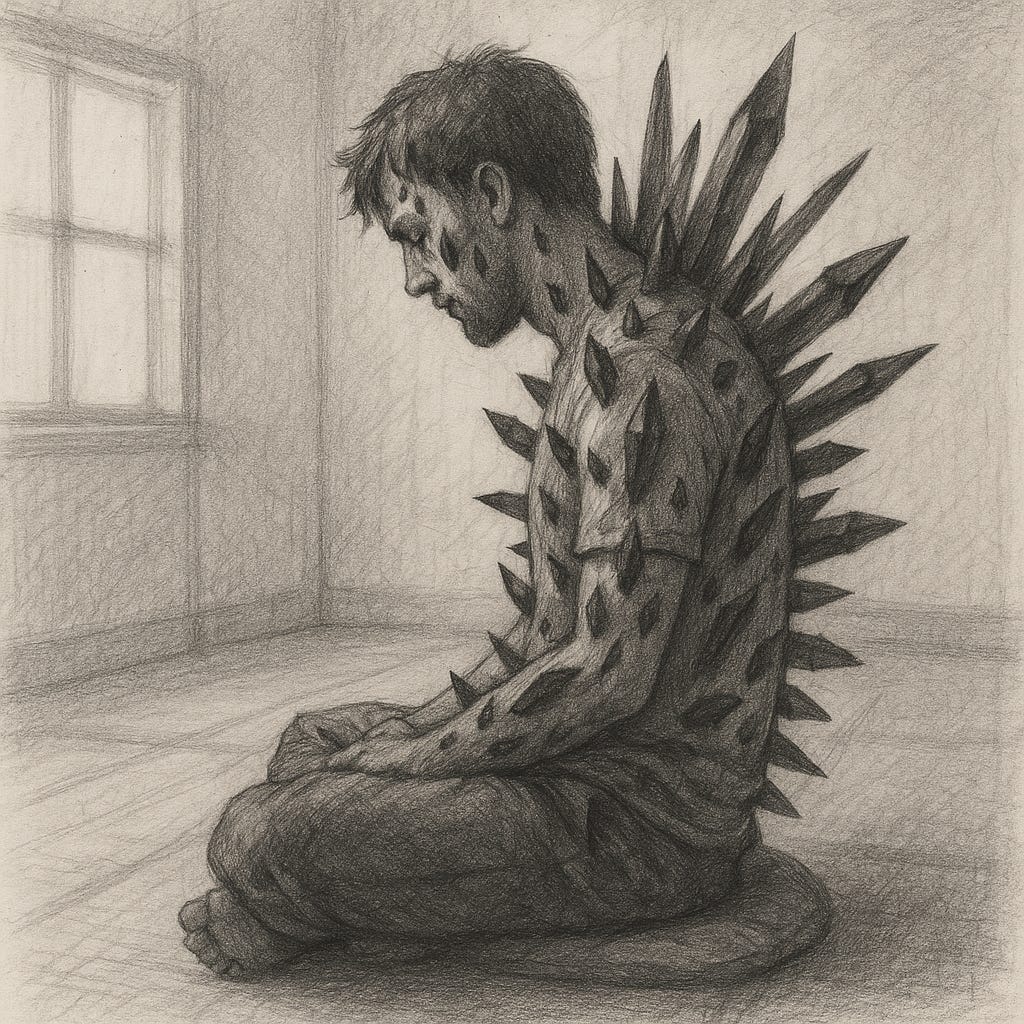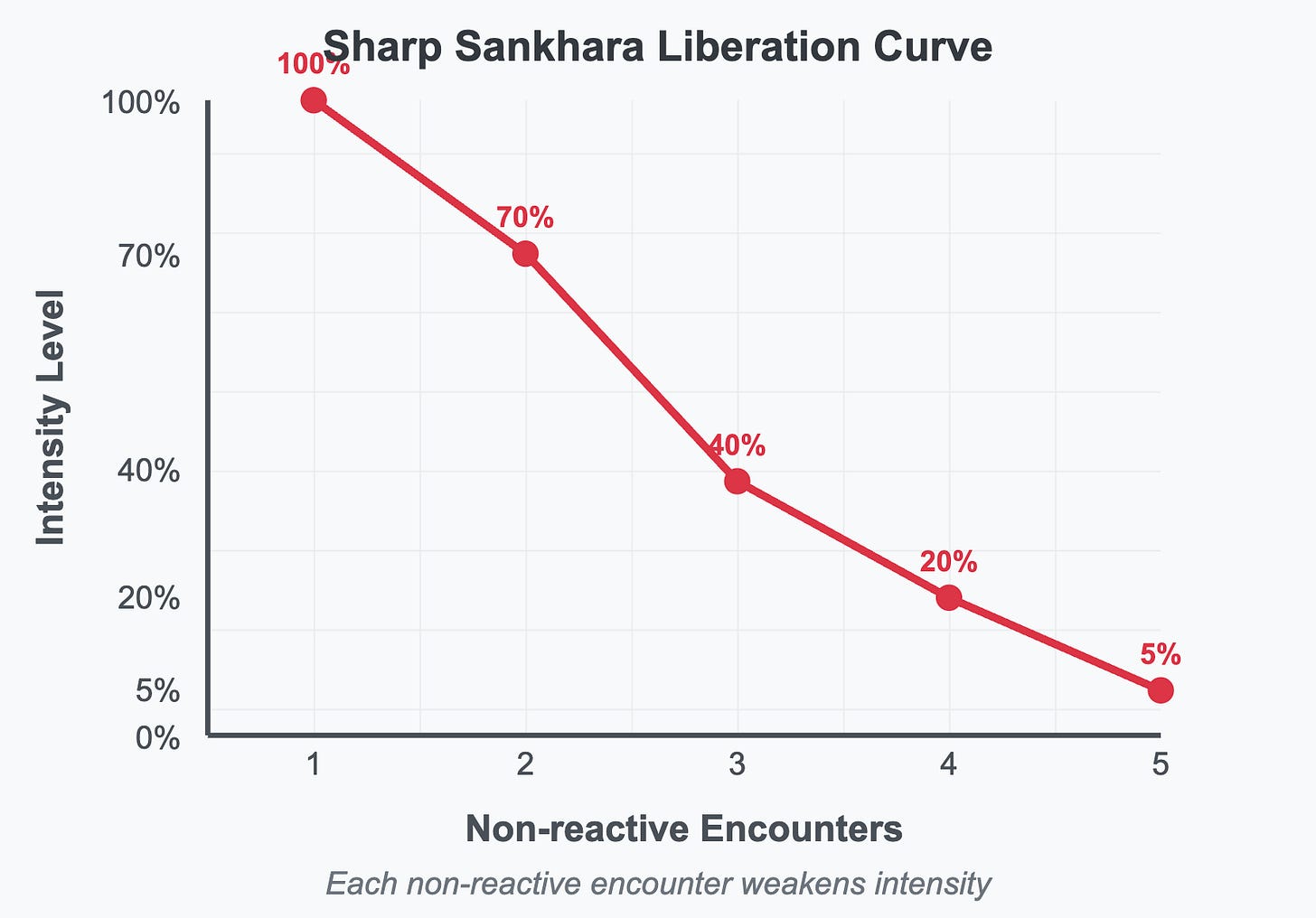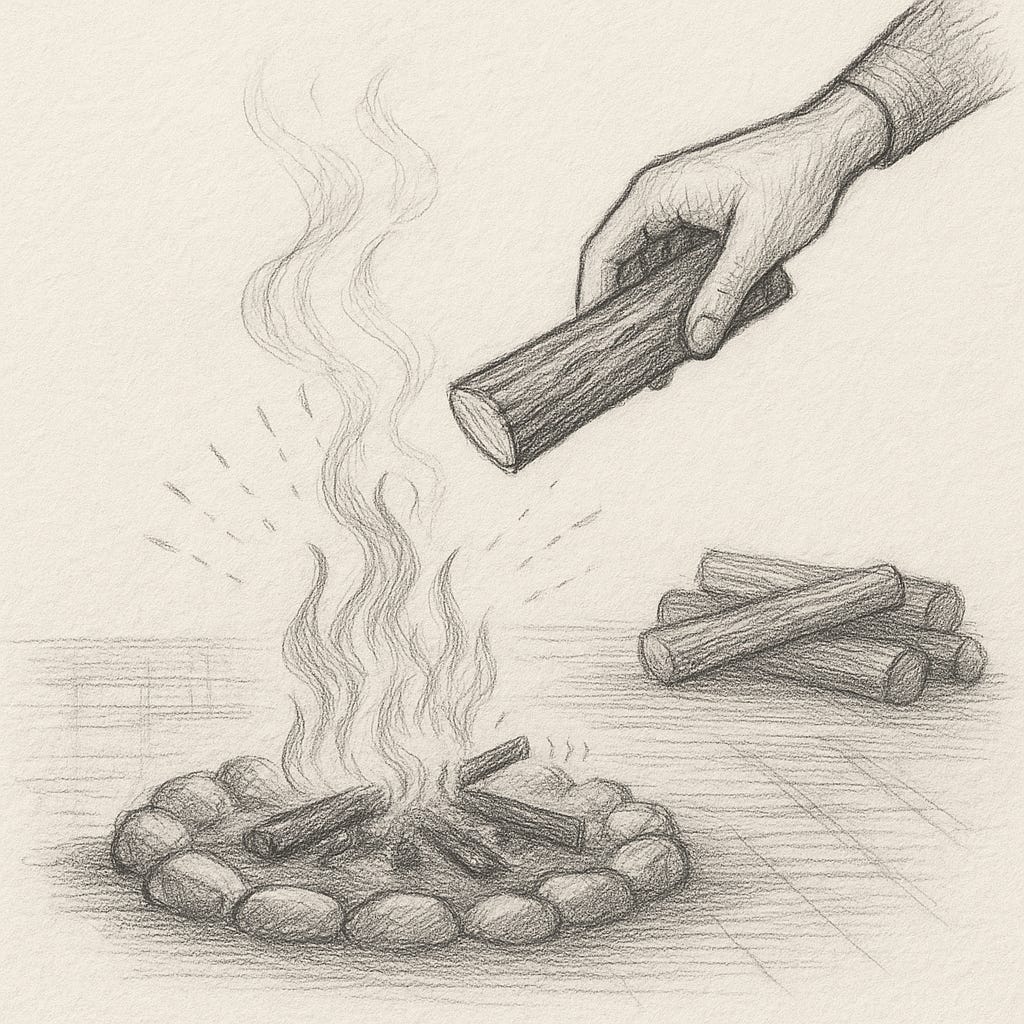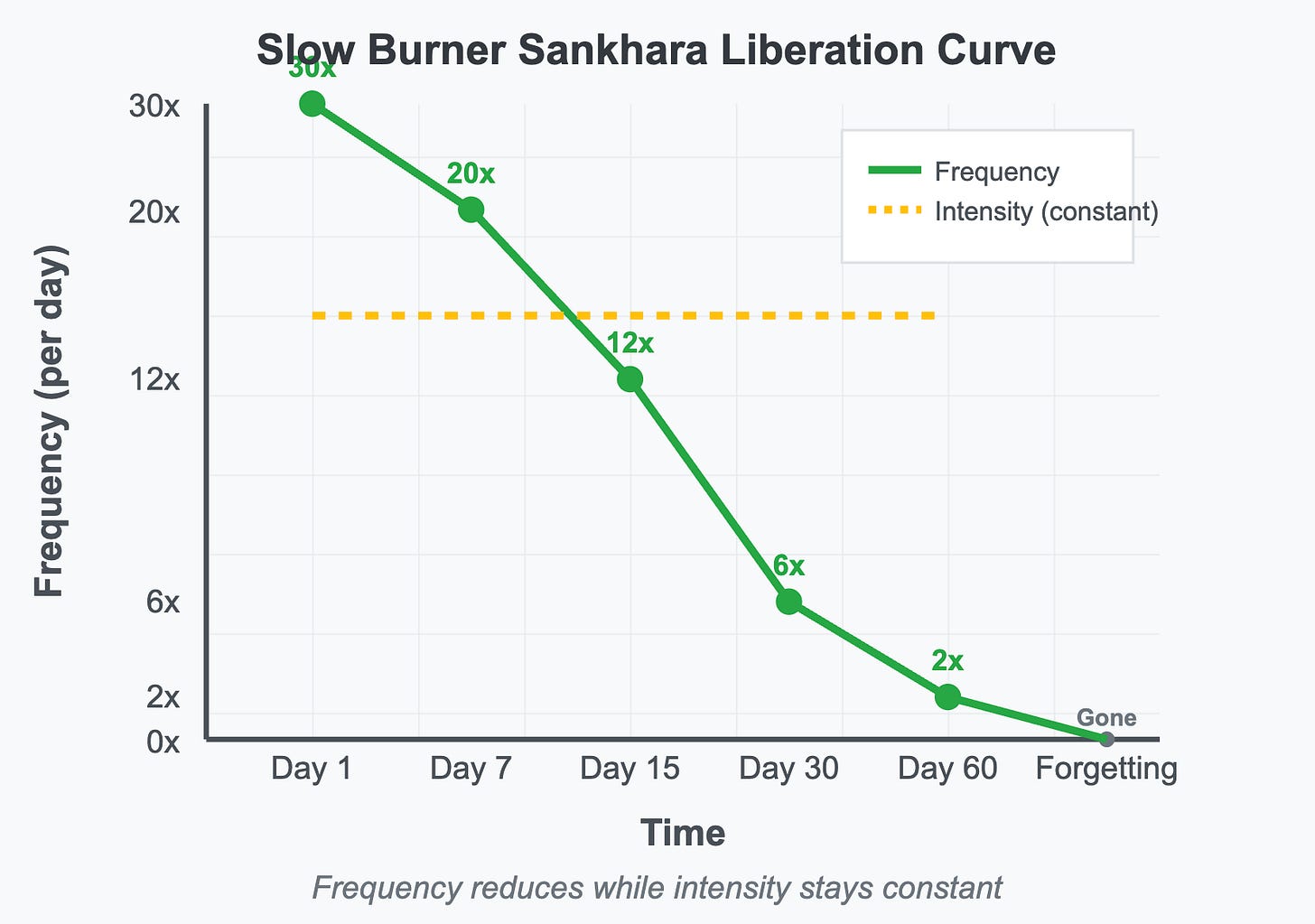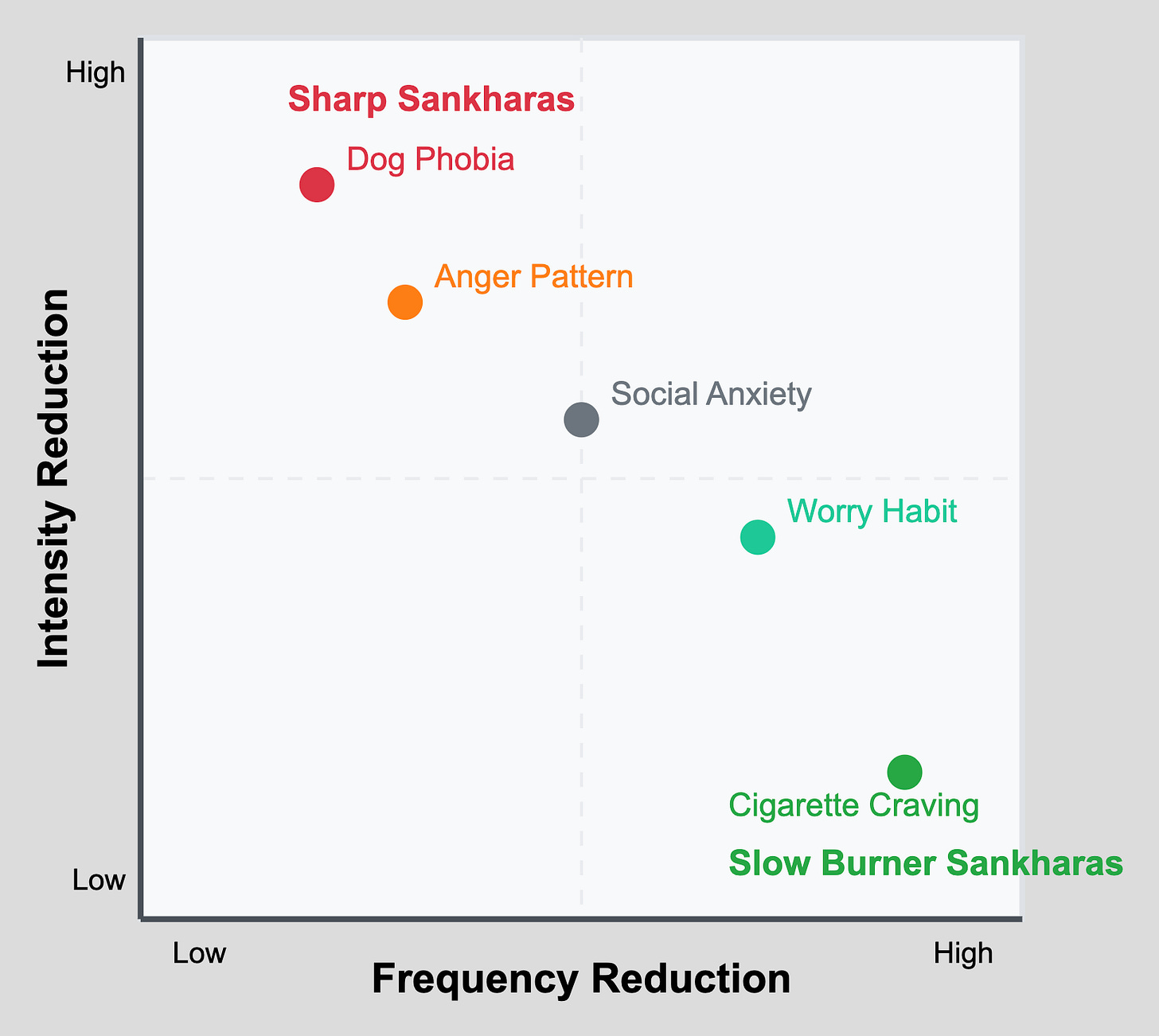The Two Types of Sankharas and Their Liberation Curves
The Framework Most Teachers Miss
Most meditators encounter the same frustrating experience: they're making genuine progress, but it doesn't feel like progress. A stubborn pattern persists, seemingly unchanged, and they conclude the work isn't working.
But what if the pattern is actually weakening in a way they can't see?
I discovered that Saṅkhāras - the mental formations we clear through meditation - come in two distinct types - with completely different liberation curves.
With the help of this framework below - understanding which type of Saṅkhāra you're facing transforms how you recognize your own progress.
The Discovery - What Are Sankharas?
I first learned what a Saṅkhāra was during my first 10-day vipassana retreat. Our Burmese teacher explained these mental formations as impurities stored in the body that we must clear to find liberation.
The clearing through meditation, combined with establishing a lifestyle where one doesn't create new sankharas, is the path to liberation itself.
Experience, not theory
We were not asked to believe this as theory. Instead, we were asked to sharpen the mind so we could see for ourselves. After about 50 hours of mind sharpening, I turned this newly focused awareness to my body.
👀
What I found shocked me. My body was covered in what felt like spikes - rough mental formations sticking out from my chest, arms, spine, everywhere.
In the years prior - I had been through severe mental trauma that had left my body completely overtaken by these sankharas. They had crystallized into pillars that barely fit inside my form.
I spent the next six days learning how to remove these things. I wanted to rip them out- but I couldnt. The process was gentler and more precise: body scanning with awareness and equanimity.
Don't react, don't feed them energy, let wisdom arise - and they weaken over time. I understood this was the point of meditation.
Before this I thought meditation was just insignificant woo woo.
But now I knew it was not so.
As I began working - I could actually feel the technique releasing me from mental knots that I had previously tried to think my way through - an approach that had only made them stronger.
Through thousands of hours of meditation and multiple retreats - both as a student and later as a retreat manager - I discovered this little framework that makes tracking progress much clearer than what's typically taught. You can use this in your daily life- but will become even more effective when you become a meditator.
What Are Sankharas, Really?
Sankharas are knots, mental formations that have stagnated in your body. When they activate, you know exactly where they have taken root. Grief lodges in your chest, anger rises in your throat, fear shoots along your spine.
What's fascinating is that these sankharas align perfectly with cultural wisdom and etymology.
Our language maps these internal territories with precision. We say "stab in the back" because betrayal sankharas tend to literally settle in the back, making us guard against future attacks.
When we "shoulder responsibility," we're describing exactly where duty and burden create tension in our bodies.
"Butterflies in stomach" captures how anxiety manifests in the gut.
"Hot under the collar" points to anger rising in the neck area.
"Heartbreak" isn't just poetry - it's the ache in your chest when love is lost.
That "lump in your throat" when you're holding back? It's a sankhara of unexpressed emotion creating real physical constriction.
When something is "chilling," fear is actually running up and down your vertebrae.
Thank you culture.
This is ancient knowledge encoded in everyday speech. You can experience this directly through direct experience when you stop putting so much focus on the mind and begin understanding how the body and the mind are intimately connected.
(Your clever mind can't solve what your clever mind helped create)
Sankharas are the formations that keeps the behaviour patterns continue their loop
The Two Types: A Framework for Tracking Progress
Sankharas fall into two distinct categories - each with its own liberation curve. This connects to what modern psychology recognizes: sharp sankharas follow exposure/extinction dynamics (intensity decreases), while slow burners follow habit loop patterns where cue frequency declines first.
Sharp Sankharas: The Ones That Scream
Sharp intense sankharas are trauma-based formations that hit like lightning. Think of a dog phobia from childhood trauma. When triggered, they create overwhelming sensations that scream "DO SOMETHING!" - run, fight, protect yourself.
These formations carry the raw energy of fear, anger, desperation, grief. Strong emotions that threaten to overpower you and demand immediate reaction. Every instinct tells you to flee, fight, or shut down.
But here's the counterintuitive key: we must go through them, not around them.
Sharp sankharas follow a clear liberation pattern - they reduce in intensity with each non-reactive encounter. Day one might feel like facing a mountain of terror. But if you can stay present without reacting, the second encounter might feel half as intense. The third time, half again.
Sharp Sankhara Liberation Pattern:
Each non-reactive encounter weakens intensity
100% → 70% → 40% → 20% → 5%Remember: The sankhara literally runs out of stored energy. When you stop feeding it with reactive behavior. (which is energy) It's like a fire that burns itself out when you stop adding fuel.
When facing a sharp sankhara, remind yourself: "This intensity is temporary. By staying present and equanimous, I'm draining its power. Each encounter makes the next one less intense."
This intensity reduction leads to something beautiful: true defeat through weathering.
Slow Burner Sankharas: The Ones That Whisper
Slow burner sankharas are entirely different. Think nicotine addiction. They don't traumatize - they seduce. Instead of screaming "DO SOMETHING!", they whisper "DO NOTHING...
“just this once... one more won't hurt. It’s not that bad, everyone does it” Etc
HOLD UP, STAY SHARP IN THE FOG. THIS IS A SLOW BURNER SANKHARA.
Here's the crucial insight that confuses most practitioners: slow burners don't decrease in intensity. They decrease in frequency.
On day thirty of quitting smoking, that craving can feel just as strong as day one. This makes people quit their practice, thinking they're making no progress.
But they are progressing - they're measuring the wrong metric.
Slow burners decrease in frequency, not intensity.
Day one: thirty cravings. Day five: same intensity, but only six cravings. The sankhara is literally starving from lack of attention.
Slow Burner Liberation Pattern:
Frequency reduces while intensity stays constant
30x/day → 20x/day → 12x/day → 6x/day → 2x/day → forgettingThis frequency reduction leads to something beautiful: true defeat through forgetting.
As the sankhara appears less and less often, it eventually fades from your awareness entirely. You don't think about cigarettes anymore. The pattern becomes irrelevant to your life.
When facing a slow burner, remind yourself: "It won't get more intense than this. If I sit calm in this fog without reacting, I am winning. Each non-reactive encounter reduces its frequency until it fades into irrelevance."
The best way to defeat something is indeed to forget about it - and slow burners teach us exactly how this happens naturally through non-reactive awareness.
The Evolution of Mental Formations
Behavior patterns that you carry, just like viruses or memes that grow into a culture, are there because they were more effective than other patterns and were specifically adapted to you and your unique bundle of sankharas. Only the most effective sankharas are still in your body. The other ones never festered.
Different sankharas have evolved different energy patterns - some fast and explosive, others slow and persistent - to ensure their survival within you.
A sharp trauma sankhara screams with overwhelming intensity because that's what worked. A slow burner addiction sankhara whispers seductively because that worked too.
The sankharas you struggle with most aren't random - they're the survivors, the ones sophisticated enough to adapt their strategies over years or decades. But here's what makes them even more persistent: they're specifically fitted to your personality, your history, your other existing sankharas. They found a match with who you are.
This creates layers upon layers of interlocking formations. When you begin clearing sankharas through meditation, new ones surface from underneath - like brushing that dirt-stomped floor, deeper formations emerge as the surface ones dissolve. Each sankhara you clear reveals others that were hiding beneath it.
Understanding this helps explain why liberation requires such precision and patience. You're not just clearing mental clutter - you're dismantling mechanisms that have been perfecting their techniques for maintaining themselves specifically within you, layer by layer.
The sankharas that persist aren't the weak ones - they're the evolutionarily successful ones that have learned exactly how to maintain themselves.
The Spectrum Reality
Sharp and slow burner aren't separate categories - they're ends of a spectrum. Most sankharas are hybrids, falling somewhere between these two poles. You can think of it like a square where one corner is fully sharp, the opposite corner is fully slow burner, and sankharas lands somewhere in that space.
Your Tracking Protocol
Step 1: Identify the Pattern Type When you encounter a challenging sankhara, ask:
Keep it simple
Is this more sharp or more slow burner?
Which liberation curve should I focus on tracking?
Step 2: Track the Right Metric
Sharp-leaning: Focus on intensity dropping
Slow burner-leaning: Focus on frequency dropping (times per day/week)
Balanced hybrid: Track both, but expect one to be more prominent
Step 3: Recognize Progress Correctly
Sharp-leaning: "This feels less overwhelming than last time"
Slow burner-leaning: "This feels just as strong, but it's happening less often"
Hybrid: Look for whichever liberation pattern emerges more clearly
The key insight: Most people quit because they're watching the wrong metric. Identify which end of the spectrum your behaviour pattern you want to get rid of leans toward, then track that primary liberation curve.
Simple awareness of this distinction will prevent you from abandoning effective practice when you're actually winning.
Track the right metrics. Trust the process. Become free.
The Universal Medicine
Regardless of type, all sankharas respond to the same medicine: awareness and equanimity. By observing without reacting, you stop feeding them energy while letting wisdom emerge. This independence-flavored wisdom is what ultimately frees you.
Here's what's happening: sankharas are actively investing energy to get more energy from you. Every time you react, you're funding their persistence. Every time you stay present and equanimous, you're cutting off their supply. They literally starve without your reactions, and wisdom emerges from underneath.
Layer by layer, formation by formation, you reclaim your freedom. Like a dirt-stomped floor, we can finally begin brushing it clean.
A fully liberated being - an arahant - has cleared these formations and developed enough awareness to prevent new ones from taking root. They sit in perfect equanimity, no longer controlled by patterns that once seemed unbreakable.
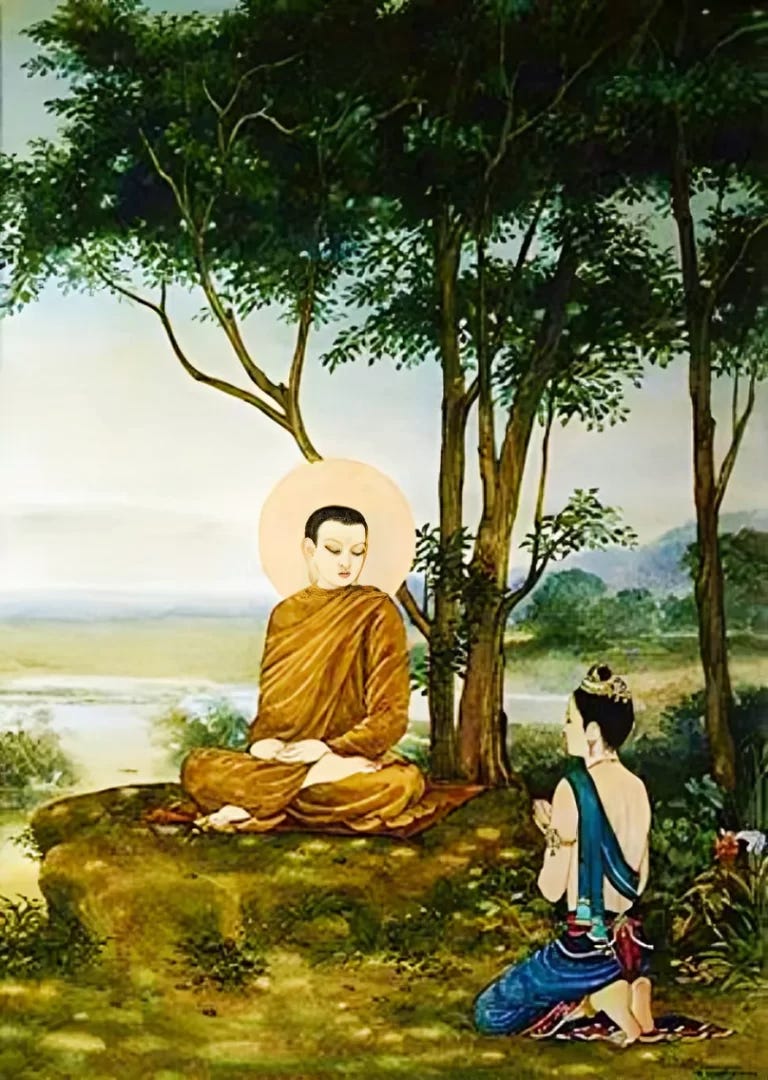
This technique called vipassana, to remove these mental formations and become liberated is what the Buddha taught even before buddhism became a thing
The Path Forward
Different sankharas, different liberation curves, same medicine. Now you have the framework to track your progress accurately.
The spikes that once covered my body are gone. The crystallised pillars that didn't fit inside my chest and spine are long gone. What seemed permanent was there only because of my ignorance.
The work is real, the progress is measurable, and freedom is closer than you think.
I wish you all the best, friend.
Lukas


